Growing orchids indoors with artificial grow lights isn’t complicated, once you know what you’re doing. In fact, it’s quite easy. Some orchid have light requirements that have to be supplemented since indoor light isn’t enough. The most vital question now is how much light is right for your specific orchid?
Once I purchased my first household plant, a Boston Fern, I quickly realized a big flaw: my house sits on all the wrong angles to provide sufficient sunlight. None of my windows get adequate sun and growing plants indoors would require some real thought.
Artificial grow lights were the solution.
I’m not an electrician. None of my electrical-conduit-processing neurons actually understand all the electrical-conduit processing, so research was mind-picking. With a ton of articles in the orchid light requirement section with information that I just didn’t grasp, I got frustrated—fast.
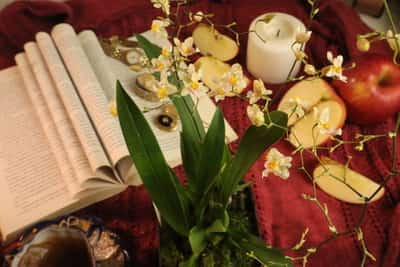
What light to use?
How long to keep the lights on?
How far above the orchids?
High Light Intensity Orchids: what’s that?
PAR? CRI? Lux? Lumens? Foot Candles?
Worse—once I saw how much they cost, I knew I couldn’t mess up.
What’s the best type of grow light for your orchid? LED GROW LIGHTS offer a full spectrum of light wavelengths, which best benefit the growth of your orchid. Both during vegetative growth/dormancy and during budding/flowering, the orchid receives the maximum amount of light without the added heat, which could cause sunburn and heat stress.
All I really wanted to know was what light was necessary for our orchids? To answer that, I first had to grasp some basic concepts, which I’ll explain below. To best choose what orchid grow light to purchase, I’ve provided a detailed explanation of the pros and cons of each one, and how to install the lights in your room.
Basic Orchid Light Requirements
Since orchids grow outside, they receive the full spectrum of sunlight (and other forms of non-visible light.) Light fixture industries saw the potential in developing horticultural products that fulfilled botanist’s necessities and produced bulbs that would satisfy this new consumer.
They made a bulb that recreated only two types of light on the wave spectrum because after many years of study, botanical industires realized that these two types influenced the growth of the orchid more than the other colors.
Results: a red wave light, which is good for flowering, and a blue wave light, which promoted vegetative growth in the orchids. (I’ll explain more on this later.)
But light in nature doesn’t come only in red and blue wavelengths. Even though the orchids develop more under the influence of these two light waves, that doesn’t mean they don’t use the other “colors”.
This is why a full-spectrum light was released a few years later, providing a wider range of light to the indoor plants. The results were fantastic: many orchid enthusiasts and hobbyists raved (in a positive way) about the lights, and flowers bloomed more vibrantly because of them.
Recently LED lights have replaced both of these. The greatest advantage of LED lights over the first two is the amount of light they produce, but mostly, heat isn’t produced. By more efficiently converting electricity into just light and not heat, they’re more cost-efficient in the long run.
Before I can effectively explain the finer details of each light and dive into the specifications of each, there’s a bit of science that I need to cover. I’ll keep it simple and straightforward, providing enough information and expertise to keep the article interesting, yet practical (Hopefully!)
Tell me in the comments below if I’ve achieved my goal. 🙂
How much light do orchids need? In the winter, they will need 12 to 14 hours of artificial light to fulfill standard orchid light requirements. Starting spring, slowly increase the hours until you reach 14 to 16 hours a day. You can purchase timers that automatically come on and off, which are really wonderful when you’re on vacation.
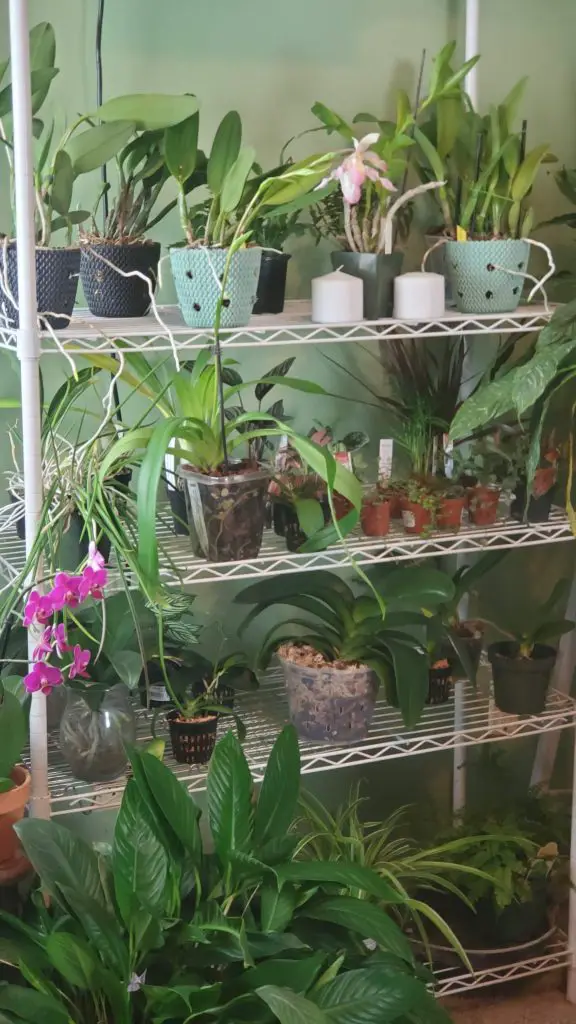
Photosynthetically Active Radiation (PAR)
All plants get their nutrients by the process of photosynthesis, which mainly is getting light from the sun and with the aid of chlorophyll, transforming carbon dioxide it into energy. It would only be natural to evaluate a lighting system on a ratio of how much light is given in relation to how much photosynthesis a plant can undergo.
Photosynthetically Active Radiation (PAR), is this measurement, which ranges from 400-700 nm (nanometers). To keep it simple, this is the same spectrum of visible light.
On the light spectrum, plants have two colors which they grow the best at, red and blue. They don’t react to green but reflect it. Remember the light developers we talked about above? Well, they got this information and produced that bulb with these two colors.
To orchid growers, this spectrum means that when red and blue wavelengths are reaching their leaves, they’re producing more energy. Depending on the orchid’s natural life cycle, if budding or dormant, the red or blue will have more effect. With this tad bit of information, light industries built the red/blue light.
Red (620-750) enhances the production of budding and flowering.
Blue (450-495) develops more vegetative growth.Red + Blue =
If you like art or remember art class from middle school, you’ll know that mixing red and blue gives you a purple color.
May I rephrase that: a horrific, nausea-inducing purple.
There is no way this sick purplish-blue light is ever making into my home office.
Sorry plants. But no—just no. I might be an orchid enthusiast, but I also take pride in home decor.
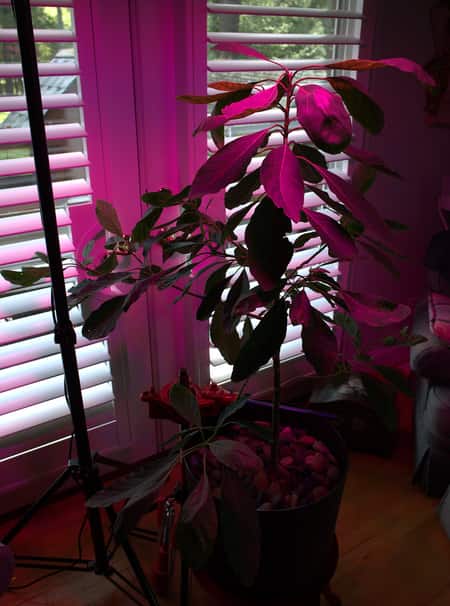
Kelvin Color Temperatures and CRI
Another important concept is the Kelvin scale. We are accustomed to measuring Kelvins for temperature, but this scale is how the temperature changes the color of the light. The same light can be a different color depending on how hot or cold it is.
This notion goes hand-in-hand with CRI (color rendering index) which is the ability of a light to produce the colors authentically. Depending on the light, some colors look a bit different.
Our goal is to imitate sunlight as much as possible in our “dark, dungeon-like” living environments. Ok, maybe not that dark, but indoor light does have a lot to be desired. For a reference, the sun is around 5000K and has a CRI value of 100.
The closer you can get to 100 CRI, your orchids will look more natural, since 100 is natural sunlight.
An example: with flourescent lights, the max you can achieve is around 85 to 90, which is pretty good. Further away from 100, the more unnatural and sicker your orchids will look.
A cool light, leaning more toward the blue spectrum will range from 5,000 to 6,500K.
As said before, blue light promotes growth in the roots and leaves. The other side of the spectrum (red part) promotes flowers and buds, ranging around 2,700K.
To be safe and fulfill orchid light requirements, pick a Kelvin of around 5,000 and a CRI closer to 100 as possible.
Warm 2700 K
Neutral 4200 K
Cool 6000 K
Foot Candles (fc)
When you grow orchids, knowing what PARs, CRIs, and Kelvins, and other types of electrical jargon that needs to be interpreted does help, but the most important concepts are just two:lumen and foot candles. (Thank goodness!)
These basically are: 1) how much light will reach the leaves and 2) at what intensity.
The most accurate way to measure the proper lighting for indoor orchid growing is by using foot candles. Foot Candles (fc) is a measurement of how much light can one candle produce in a foot’s distance. For example, the sun produces 10,000 fc on a bright summer day.
On a rainy day with thick, overhead clouds, only 1,000 fc are reaching the orchid leaves.
Some orchids love bright sun, others prefer shade. When classifying orchids to how much direct sun they like, there are 3 categories:
Low-light orchids require 1200-2000 fc
Medium-light prefer 2000-3000 fc
High-light orchids thrive with 3000 fc.
Note: It’s easy to mix these numbers up with Kelvins, which are also in the thousands, and usually what light-industries put on the package. Remember, Kelvins are color/temperature measurements. Foot Candles is how much light is given.
For math people: To convert the fc to lumens, 1 fc is equal to 10.764 lux, or 10 lumens per square meter.
This is important to know because many orchid growers will market their plants with the foot candles requirements, but lighting industries market their products with lux, or lumens.
Your Orchid Will Tell You It’s Light Requirements
Kelvin, PAR, CRI, or foot candle… If you’re like me, then what’s going to dictate the right light is in fact, your orchid. Observe the leaves. If they are a deep, dark green color, almost tending toward spinach, then they are in desperate need of more light.
If they are spotting, and turning a bit pinkish-red on the exterior, they could be getting too hot, but just the amount of sun needed. The reddish pigment (which is the orchid’s naturally produced sunscreen) could mean that it’s not the orchid light requirement that’s off, but that they’re low on nutrients or just too cold. Be sure to check those out before you move them to a shadier place.

If they are turning yellowish-green, then they have too much sun, and you need to move them as soon as possible.
Some high-light orchids do not tolerate as much light as they’re marketed as.
You need to do your research on specific names to discover how to better care for your orchid.For example, it’s easy to say that all Vandas are high-light orchids. In fact, some species are more medium-light, depending on their parents. If you place them in high-light conditions and forget about them, it’s likely you’ll discover sunburned leaves and overheating problems, which can be irreversible.
Now that the science part is over, let’s get on with the information you actually came to get. What light is best for my orchid? In essence, there are 4 types of grow lights you can use:
Fluorescent
CFL (Compact Fluorescent lamps)
HID (High Intensity Discharge)
LED Grow Lights
1) The “Idea” Light Bulb, Found in Supermarkets
We have to mention this one just to say don’t use it. The orchid light requirements just don’t get met. Even though these incandescent lights burn around 2700K, which is great for flowering and budding, but on the downside, produce tons of heat and have to be replaced every 3 to 5 months.
Half the energy is wasted by heat production. You’re paying for that heat, too, which does nothing positive for the orchid.
If you have no other option, then try to get a halogen light, which is a better version of the incandescent bulb, producing a third more of the light. Keep the orchid leaves far away from the plant, so the heat won’t produce stress in the leaves. Of course, this lessens the efficiency…
Enough said about this one—just cross it off your list. Incandescent Lights
2) COMPACT FLUORESCENT LAMPS (CFL)
If you’re just starting with orchids, or the room you have your orchid in has a well-lit window but you’re just wishing to supplement a tad bit, two fluorescent bulbs should be sufficient. If you’re renovating your attic or basement into the next modern greenhouse, and there are no windows or natural light, then aim for four bulbs per shelf.
The shelf your orchid collection sits on mustn’t be wider than 22 inches, if not the fluorescent bulb will have little effect on the orchid. Install right under your light, which should be 4 to 12 inches above your orchid.
In general, the closer the better, but allow room for a flower spike. Strictly speaking, if you divide the distance from the light to the top of the orchid by 2, then you quadruple its intensity.
Another way to double the efficiency of your lights, whatever kind you use, is by using a reflector on the backside of the bulb. Light will reflect onto the orchid and not be wasted illuminating, well…nothing.
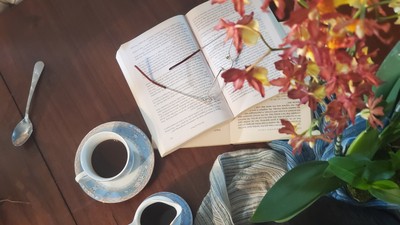
If you decide to go with the fluorescent tubes, note that not a single tube will do the job efficiently.
You’ll have to mix and match to achieve the right lighting. Oscillating between cool and warm lights, this can be done.In the past, there were mainly two types you can choose from: the 48-inch 40 watts, or the 96-inch 74 watts. Today you can buy any size and wattage you’d like. You can even combine two categories of lighting, resulting in the High-Intensity Fluorescent bulbs, which mainly places you in the category below. For these, you’ll need to have a special light fixture, which raises the initial investment.
Our recommendation is to go with the normal fluorescent 45 to 60 watts if you have only one or two orchids. If you have a dozen or more, then aim for the 250w.
PROBLEMS: These lights don’t provide the best lighting for your orchids. They will grow, but not to their full potential. Mixing and matching bulbs is essential. Buy a cool light (4000K) and next to it install a warm light (2700K). This works well.
COST: The cost of fluorescent bulbs is wonderful—at first. After 1.8 years, they need to be replaced completely, since they are working at only 10% of their potential. They last longer than the regular light bulb, maxing out 5 months, but every two years adds up quickly.
MAINTENANCE: For maintenance, wipe down the bulbs once a month to remove dust and air particles that accumulate on the surface. Even though we don’t see these much, they do interfere with how much effective light the orchid is receiving. Regular maintenance is extremely important.
ORCHIDS THAT LIKE FLUORESCENT BULBS: Always try natural light first. If you happen to be blessed with sun that pours through your windows, keep these low-light orchids out from direct beams. Early morning light and late afternoon light are the best, but never direct sun. If that fails or is insufficient, use the fluorescent lights to complement these low-light orchids. They are wonderful candidates for artificial light.

Fluorescent lights are perfect for low-light orchids, like
Phalaenopsis (Moth orchids,)
Paphiopedilum,
Militoniopsis (or Pansy orchids) and Nelly Islers.
Fluorescents fulfill these orchid light requirements well.By low-light orchids, we mean orchids that still want abundant, bright light, but not direct sunlight. These more sun-sensitive orchids don’t produce enough hormones that protect them from direct sun, and they can be easily prone to sunburn, overheating, and be affected by heat stress. The perfect place for these orchids is in bright shade.
Some orchids don’t fit into the low-light orchid requirements but also sunburn with too much light. These are called the medium-light orchids,which prefer 2,000 to 3,000 fc. Many Oncidiums, Miltonias (don’t confuse the Miltonias with the Militoniopsis mentioned above). Brassia, and Dendrobiums can fit into this category.
These medium-light orchids cherish fresh sunlight during early morning and late afternoon, but prefer bright shade if at all possible. A window sill is perfect as long as they don’t get direct sun on their leaves for a long period of time.
For artificial lighting, they’ll want a lower light, but closer too them. To correctly supply lighting to these, we recommend using a combination of Fluorescent lights, or a High Intensity Fluorescent Light.
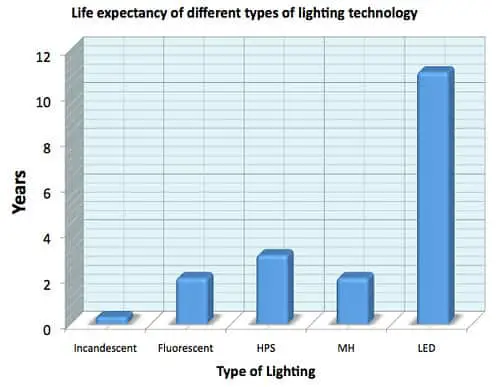
Image Credit: “Grow Lighting Life Expectancy Chart” by byr7 is licensed under CC BY 2.0

3) HIGH-INTENSITY DISCHARGE LIGHTS (HID)
HID lights are specialized in producing the red/blue spectrum that your orchids grow so well in. There can be a few options in how this light works, but the main three are: mercury vapor, high-pressure sodium, and metal halide.
PROBLEMS: There are two problems with these lights though: 1) cost and 2) heat production. They have the advantage over the simple light bulb in that the intensity is far stronger than your average light bulb, but even so…they miss the target PAR and don’t hit the full spectrum, lacking on the ends.
Since they’re so high intensity, the production of heat raises your energy bill, almost skyrocketing it. Also, the wattage can be a bit too much for your orchid. Not only do these lights fulfill the orchid light requirements, they do so way too much. Instead of the four inches away from the orchid as used in Fluorescent lights, HID need to be further away depending on the wattage.
If you have a 250W bulb, then keep it about a foot away from your orchid. If it’s still too strong, move it to three feet. With the 400W, three to five feet, and so on… Up to the 1000W, which should be almost at ceiling height.
If you’re not sure which to purchase, go with the 400W.
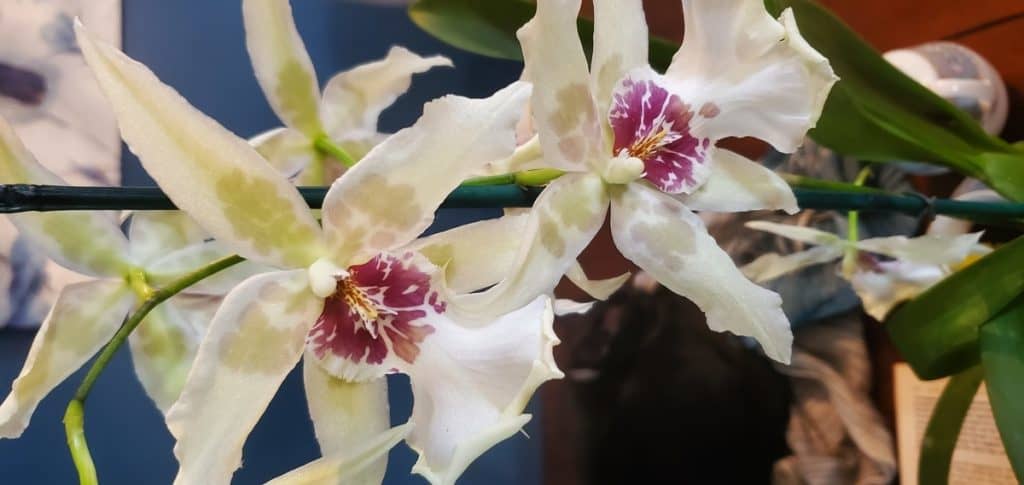
COST: The cost of the bulbs is extremely high. It’s true that the higher the wattage, the more you’ll save in electrical usage—cost efficient. But still not cheap. The overall cost of these lamps is still very high. Besides, you have to change these lights every two years.ORCHIDS THAT LIKE HIDS: The higher intensity lights are more adequate for high-light orchids, which makes sense.
What is a high-light orchid? Any orchid that thrives in over 3,000 fc of direct light is a high-light orchid. Vandas, Cattleyas, and Brassavolas are great examples. Dendrobiums can fit into this category, but do some research to see who the parents are and its specific species. Some don’t like that much light.
This still doesn’t mean these orchids thrive in direct sunlight all day. Don’t go to extremes by overfill the orchid’s light requirements. They do tolerate more direct sun and hotter temperatures than other orchids do. Always feel the leaves to see if they are hot. If yes, move the orchid.
Heat kills orchids—a silent murderer—who gets away with so many orchid deaths since not many people address heat issues in growing orchids.
How much light is too much? There is a simple method that doesn’t require math (yeah!) which is pretty accurate. Place your hand in the path from the light to the orchid, about 6 inches above the leaf. Observe the shadow. If you can trace the shadow perfectly, then your light is too strong. Move either your orchid or the light. Test again. If your shadow is traceable but not as sharp, this is ideal. If your shadow is just a bur, a deeper, undefines outline, then your light is too weak.
Don’t Stop Learning!
If you want to be included in more information and get a 14-page fertilization guide, please sign up for my newsletter. I don’t spam, but send emails out bi-monthly with some curious topics of interest. If you want more information, click here to go to a specific page on this website where I explain it more in detail.

Also, if you are looking for an orchid journal to keep your notes specifically about orchid care, check out my 2 solutions for that on this page. If note-keeping isn’t your thing, then there is a free excel spreadsheet that you can download. Click here for more information on how to do that.
If you subscribe to my newsletter, I will send you a 14-page guide on the main tips of orchid fertilizer. It is downloadable and you can print it out on your computer. I designed the guide to double up as a coloring book, just to make it fun.
4) LED GROW LIGHTS
LED lights finally are the answer to most indoor problems.
LED lights are available in a variety of light spectrums, dictated by what you want to achieve with your orchid. Being full spectrum, they fulfill orchid light requirements that other lights couldn’t. The other positive note is that they don’t produce heat. No heat whatsoever! Yeah! You can place your hand on the light and the shade will be cool to the touch.
Why is this such great news to the orchid hobbyist? Orchids react to heat, producing a hormone that acts as a sunscreen. It’s actually a red pigment, and the more sun it’s exposed to, the more it produces.
Heat has the same effect.
If the environment is too hot, the stomata close, shutting off any gas exchange in order to salvage humidity. You can read more about how this works in this article about humidity. In summary, the orchid doesn’t perform gas exchange if it’s too hot. Lights that produce heat will induce cell death.
With no heat being produced by LED lights, you won’t need a supplemental fan to cool down the lighting system. Some of the HID lights have built-in fans, which are quite noisy. You will need a continual fan to promote air circulation, but not to lower the temperature of the orchid leaves.
In the article your reading now, we’re only observing the orchid light requirements and preferences. Failure to recognize orchids have temperature preferences, too, will result in not flowering. Some that don’t like high, other too low… Very Goldilocks-type.
Even if an orchid likes high or medium light, that may not mean temperatures. If you have a more cool-temperature orchid, like Pleurothallis or Masdevallia, then LED lights are the best option, since they are high-light but low-temperature orchids.
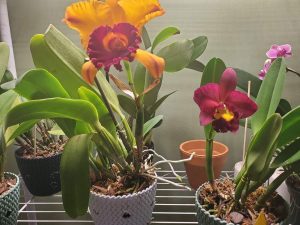
How long do LED lights last?
More than a decade. This is where the money really comes in to play. By the time you change out all the lights five times (the fluorescent last 2 years) you’ll pretty much have the costs covered.COST: For our pocketbook, they are an initial investment of a lot of money, but in the long term, are far more beneficial. The cost less to operate, and by less, the final cost is about 55% less of what a HID would cost. Some articles say up to 75% but we’re skeptical about that much since we haven’t seen that yet, but it is overall lower, yes…
PROBLEMS: Please reread the last paragraph… How much is this going to cost me???? If you’re just starting out with orchids, this initial investment will be quite high. Is it worth it? Will you even like growing orchids? What if you fail? We know… We’ve asked the same questions.
Our suggestion is to go with a less expensive light to get the idea of indoor lighting, and slowly replace your lights with LEDs as you get more experience. That way it won’t feel like such an impact financially.
If you’re wondering about what lights I use, you can go to this page on Amazon (Affiliate Link) . It’s a smaller LED GROW LIGHT, perfect for my orchid shelf. I have it installed in my home office, so I didn’t need a monster-sized light or one that was very expensive either.
. It’s a smaller LED GROW LIGHT, perfect for my orchid shelf. I have it installed in my home office, so I didn’t need a monster-sized light or one that was very expensive either.
Now that you know all about growing orchids with artificial lighting, what orchid light requirements are, what bulbs to looks for, and how far above the orchids to install them, it’s time to get your hands dirty. Check out some of our tutorials on how orchids adapted to better live, what orchid to give as the perfect gift, and more. Design a great floral design or build a terrarium with orchids.
If this information was of any help or clarified any doubts you had, please mention so in the comments. If you want more information, please check out this article on how to set up an indoor orchid space, that is perfectly compatible with your home office.
Don’t Stop Learning!
If you want to be included in more information and get a 14-page fertilization guide, please sign up for my newsletter. I don’t spam, but send emails out bi-monthly with some curious topics of interest. If you want more information, click here to go to a specific page on this website where I explain it more in detail.

Also, if you are looking for an orchid journal to keep your notes specifically about orchid care, check out my 2 solutions for that on this page. If note-keeping isn’t your thing, then there is a free excel spreadsheet that you can download. Click here for more information on how to do that.
If you subscribe to my newsletter, I will send you a 14-page guide on the main tips of orchid fertilizer. It is downloadable and you can print it out on your computer. I designed the guide to double up as a coloring book, just to make it fun.
I love to interact with other orchid enthusiasts, and can share from our experiences. Share this page with a friend who has an orchid, comment, or give me a thumbs up 😊 in the comments below.
Happy cultivating!


Hi Amanda! Just wanted to say I thoroughly enjoyed reading everything on your site! It was a fun read if that makes sense lol!
Looking forward to catching up on everything I missed.
Lisa
Hi Lisa,
Thank you for the kind words! I appreciate it so much! 🙂
-Amanda
Great article! Really in depth! I am using LEDs now and came across your article trying to find length of day. I have my footcandle meter but understand an orchids recommended Fc is like its maximum. I was running these lights 16 hours a day in my studio and want to run them less. They are all flowering and leaves are bright green, so I know the level is good. Your’e right, there are so many variables, it makes indoor culture difficult.
Hi Michael,
Thank you for leaving a comment! Made my day! 🙂 During summer you can leave them on that long, but it’s really pushing the upper limit. Now that we’re going into autumn (well, at least I am in Kansas–depends where you’re from) it’s time to cut those hours back a bit. I’d use them a bit less each day until winter hits. Then you can either keep them on 12 hours a day in lower light, or use less hours (like 8-10)with brighter/higher light. <--Not sure if I explained that well. -Amanda
Hello, I am new to the lighting world.I found your article extremely helpful and easy to understand.i only have a dozen phals and phaps so i dont need lots of lights.You have helped me to understand my requirements.
Thankyou very much
Robyn G
Hi Robyn,
Thank you so much for your comment! I really appreciate it. And you are correct, neither phals nor paphs require lots of light. They’ll even grow in a window that faces north, depending on the season. I wish you the best in your orchid growing!
-Amanda
Your comments about lightning were extremely helpfull
Hi David,
Thank you so much for leaving a comment! I appreciate it! 🙂
Amanda
Thanks for an excellent read. I have 10 med to high light orchids. I went to the sight you got your light for your office but I’m still confused about what size fixture I should look for.
Hi Stephanie,
Thank you for your comment. 🙂
The size of the light is really up to what kind of shelf length you have. A shorter or longer light will not influence the amount of light directly, since the most important thing is how close to the light you place your orchids. If you have a longer shelf, go for a longer light, and vice-versa.
-Amanda
Hi Amanda,
Thank you for providing practical advice about lighting (finally!). This has been my biggest frustration and your article was VERY helpful. I hope it is ok to ask a question specific to my situation, as I am still a little unclear about what to purchase, after going to the website you recommended.
My shelving unit has 2 wire shelves that are 48 in long and 18 in deep, with humidity trays on each shelf.
I was thinking I would need lights installed on each shelf, 12 inches above the tops on the plants. If that is correct, do you think the size that you purchased would work out ok for this size shelf? (trying to be economical).
I am a little confused because it sounds like you have one light installed for your entire shelving unit. Thank you again for your help!
Hi Charlotte,
Thank you for your comment. I appreciate it!
Yes, I have just one grow led light and that one is so powerful it’s hard to even look at it. Yet I don’t have humidity trays set up under my pots so the light can reach all three tiers.
In your case, I’d suggest getting a light that isn’t so strong (such as the flourescent blue and red ones) and installing them for each shelf. That seems to work best with the set up that you have.
-Amanda
Just purchased a LED light for my orchids… I can set the light. To blue and red….just white. Or blue,red and white. No idea what setting to use…Thinking red and blue, after reading your article… Thoughts?
Hi Helen,
I’d have to read the specific manufacturing guide to know what the settings are, since each company is different. Without knowing this company’s brand, I’d go for the red and blue. Maybe the company has a hotline and you can ask there?
-Amanda
Hello I liked your site it’s very informative I have a question I’m new to orchards, I love them there so beautiful I bought about 10 total I big investment for me as soon are over ten yrs old. I got nice ones for indoors I live in fl were you can grow some outside what I have is the vanilla been orchid it’s say bright shade what’s that’s mean I thought I had it covered I kept them in wire cages wrapped with 4 layers of white plastic sheets to block bright sunlight but the leaves burned some and got yellow I moved them indoors and bought a grow light at 5000 kelvin it’s a 8 foot florescent with 4 -t8 bulbs I might buy a couple more bulbs to mix for a lower spectrum I need to better understand what the natural light is as I’d like to grow them outdoors in summer if possible, glad I found your site I know about lights and all but the amount of light indoors or outdoors I don’t, they say they grow them on trees to shade them but most of my trees get direct light off and on. If you have time to answer I’d be most thankful Nick
Hi Amanda!
I’m relatively new with my orchid hobby. I’ve surprisingly kept one alive for 3 years so far. I recently purchased another and was gifted one. All three are Phalaenopsis’. I live in South Central Texas, where summer is the longest season we have (which is really only two….hot or cold (more like just cool). My house doesn’t provide the ideal lighting, just enough not to kill them. Your article was very informative, and will get me on the right track for the best lighting to give my babies. lol. You’ve inspired me to start a journal too! I’m looking forward to reading your bi-monthly newsletters.
Great articles, thank you. I have several grocery store orchids. They have dark green thick leaves and reside on a long table. Above the table is one hanging light with a wide shade that encompasses all the orchids. The table is in front of two French doors. The exposure is West but gets just a little bit, not much, of sunlight now in the Winter in Colorado. I had a blue reflector light in the lamp but it seemed to radiate hot heat. I had it at about 2 feet above the plants. So, I replaced the bulb with a green bulb. Since I read your articles, I am just “cornfused”. What’s a mother to do? Can you advise me as to what color bulb to use?
Hi. I have been growing Phals quite successfully for a few years now and I just ventured into trying cattleyas. I have separated them into two different greenhouses in my home. I want to buy a grow light for the catts. What light do you use specifically. Your setup looks like mine. I have dendrobiums, and others as well and some micro orchids too. Thank you
Exceptionally well written. Great mix of science, experience and the motivation to experiment. LED lighting has enabled so many new applications. I have a dark attic that has plenty of space and would like to utilize it to promote orchid blooms.